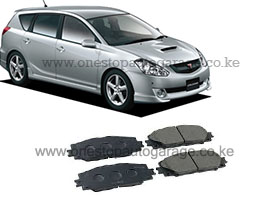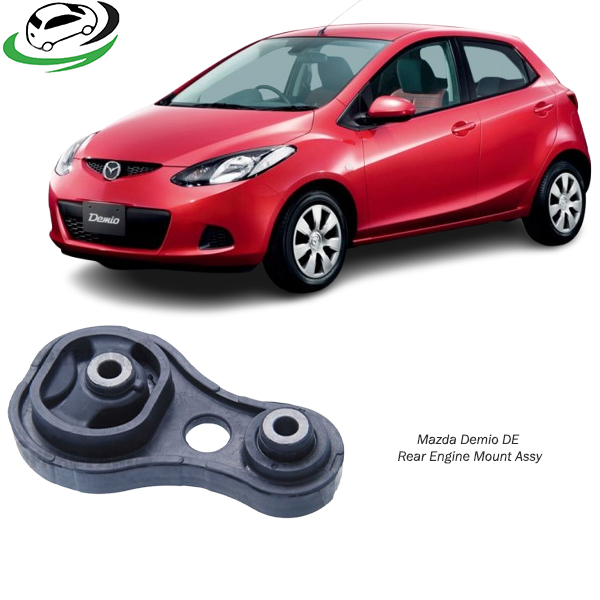-13%
Get Mazda Demio DE Rear Engine Mount mzm-demrr in Kenya
The rear engine mount is a crucial component in a vehicle’s engine mounting system, securing the engine to the chassis while absorbing vibrations and minimizing noise. This component plays a vital role in ensuring a smooth and stable ride, as well as preserving the longevity of various engine and transmission components. Unlike the front engine mount, which primarily supports the engine’s weight, the rear engine mount stabilizes the engine’s movement from front to back, especially under acceleration and deceleration.
Here’s an in-depth look at the rear engine mount, its design, functionality, maintenance needs, and the benefits it brings to a vehicle.
1. Overview of the Rear Engine Mount
The rear engine mount is one of several mounts that anchor the engine to the vehicle’s frame. In a typical setup, the engine and transmission are mounted to the chassis at three to four points, with the rear engine mount often positioned at the rear of the engine block, near the firewall. This strategic positioning plays a significant role in absorbing vibrations and stabilizing the engine’s back-and-forth motion.
Mounts are typically constructed from a combination of rubber and metal. The metal bracket secures the mount to the chassis and the engine, while the rubber or synthetic elastomer section absorbs vibrations and reduces the transfer of engine movement to the vehicle’s frame.
2. Functionality and Purpose
The primary functions of the rear engine mount include:
- Vibration Absorption: The rubber or elastomer within the mount acts as a cushion, dampening engine vibrations before they reach the cabin. This enhances passenger comfort by providing a smoother ride.
- Engine Stability: The rear mount stabilizes the engine’s position, preventing excessive movement during acceleration, deceleration, and cornering. This stability protects other engine and transmission components from undue stress and reduces wear over time.
- Noise Reduction: By isolating the engine from the chassis, the mount reduces noise and minimizes vibration transmission, contributing to a quieter driving experience.
- Protection of Adjacent Components: A stable engine is essential for the durability of other vehicle components, such as hoses, wiring, and various engine sensors. Excessive engine movement can strain or damage these parts, leading to costly repairs.
3. Types of Rear Engine Mounts
Rear engine mounts are available in several varieties, each suited to different performance levels and driving conditions. The main types include:
- Rubber Mounts: Rubber is the most common material used in engine mounts due to its effective vibration absorption. Rubber mounts are ideal for most passenger vehicles, providing a balance of comfort and durability.
- Hydraulic Mounts: These mounts contain a hydraulic fluid chamber that further enhances vibration dampening by absorbing a greater range of frequencies. Hydraulic mounts are common in luxury vehicles, where additional comfort is a priority.
- Polyurethane Mounts: Polyurethane mounts are stiffer than rubber and offer increased durability, making them ideal for high-performance or heavy-duty applications. While they offer better stability and longevity, they can transmit more vibration to the cabin.
- Electronic/Active Mounts: Some modern vehicles use electronically controlled mounts that adapt to the driving conditions by adjusting the amount of damping. Active mounts offer excellent vibration reduction, but they are more complex and costly than traditional mounts.
Each type of rear engine mount has unique benefits, making it essential to choose the correct one based on the vehicle’s requirements and intended use.
4. Signs of a Worn or Failing Rear Engine Mount
Over time, engine mounts can wear out or fail due to constant exposure to engine heat, weight, and vibrations. Here are some symptoms that may indicate a failing rear engine mount:
- Excessive Vibrations: If you start noticing increased vibrations in the cabin, especially during idle, it could be a sign that the rubber in the rear mount is deteriorating.
- Engine Movement or Rocking: A worn rear engine mount may no longer keep the engine securely in place, causing it to shift or rock back and forth when accelerating or decelerating.
- Unusual Noises: Clunking or banging noises coming from the engine bay, especially when changing gears or driving over bumps, may indicate a damaged rear mount.
- Visible Damage or Wear: If the mount’s rubber appears cracked, hardened, or torn, it’s likely worn out and needs replacement.
- Increased Engine Misalignment: A failing mount can cause the engine to sit improperly within the engine bay, affecting the alignment of belts, pulleys, and hoses.
Ignoring these symptoms can lead to further damage, as excessive engine movement can strain the exhaust system, transmission, and other mounts, leading to additional wear and costly repairs.
5. Causes of Rear Engine Mount Failure
Rear engine mounts are designed to withstand extensive use, but they may still fail prematurely due to several factors:
- Exposure to Heat and Oil: Constant exposure to high temperatures, especially in the engine bay, can cause rubber mounts to harden, crack, or degrade. Oil leaks can also weaken the rubber, reducing its effectiveness over time.
- Driving Conditions: Aggressive driving, such as hard acceleration or abrupt braking, puts extra strain on the rear engine mount. Rough terrain and frequent off-road driving can also increase wear.
- Aging and Wear: Like most components, engine mounts deteriorate naturally over time. Even under normal driving conditions, rubber mounts can lose elasticity and effectiveness.
- Improper Installation: If the mount is not installed correctly, it may not function properly and could wear out faster than expected.
Understanding these causes can help drivers take steps to prolong the lifespan of their rear engine mount, such as avoiding aggressive driving and addressing oil leaks promptly.
6. Maintenance and Replacement
Maintaining and replacing the rear engine mount as needed is essential for vehicle health and safety. Here’s an overview of the maintenance and replacement process:
Inspection
Regular inspection during routine maintenance is recommended, especially if the vehicle has logged significant miles. Mechanics can check for visible signs of wear or damage, such as cracked rubber or loose bolts.
Replacement Process
Replacing a rear engine mount typically involves several steps and should be performed by a qualified mechanic:
- Lift and Secure the Vehicle: The vehicle is lifted to provide access to the mount.
- Support the Engine: A jack or engine support tool is used to hold the engine in place when the mount is removed.
- Remove the Old Mount: The bolts securing the old mount are removed, and the mount is detached from the engine and chassis.
- Install the New Mount: The new mount is aligned correctly and bolted securely to the engine and frame.
- Double-Check Alignment: Once installed, the mechanic ensures the engine is properly aligned and that the new mount is secure.
After replacing the mount, it’s advisable to test drive the vehicle to confirm that the new mount is functioning correctly, with improved vibration control and stability.
Choosing the Right Replacement
When selecting a new rear engine mount, it’s important to match the replacement part with the vehicle make and model. Rubber mounts are ideal for most passenger cars, while polyurethane or hydraulic mounts may be better suited for performance or luxury vehicles. Consult the vehicle manual or seek advice from a mechanic to select the right mount.
7. Benefits of a Properly Functioning Rear Engine Mount
Replacing a worn rear engine mount offers numerous benefits:
- Enhanced Driving Comfort: A new mount restores the vehicle’s ability to absorb vibrations, resulting in a smoother and quieter ride.
- Improved Engine Stability: A properly functioning mount keeps the engine secure and aligned, reducing stress on other components and prolonging their lifespan.
- Increased Safety: With a stable engine, drivers can maintain better control of the vehicle, especially during sudden stops or turns.
- Reduced Maintenance Costs: By stabilizing the engine, a new mount reduces the risk of damage to surrounding parts, potentially lowering future repair costs.
8. Conclusion
The rear engine mount is an essential component of the engine mounting system, designed to absorb vibrations, enhance stability, and ensure a smooth driving experience. While small in size, its impact on vehicle performance, comfort, and longevity is substantial. Regular inspection and timely replacement of worn mounts can prevent more extensive damage and ensure that the vehicle remains comfortable, safe, and reliable on the road.
Whether you’re driving a performance car, an off-road vehicle, or a standard passenger car, maintaining a fully functional rear engine mount is crucial to keep the engine secure, protect other components, and enjoy a quieter, smoother ride.
Follow us on Facebook for more parts.



